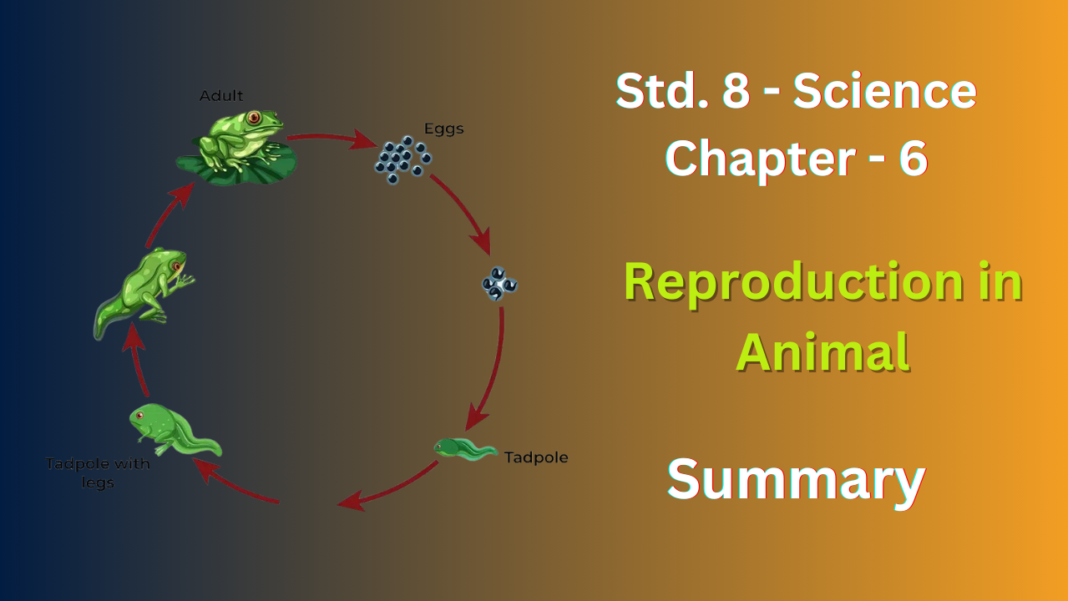NCERT Solutins for Class 8 Science Chapter 6
The chapter on Reproduction in Animals covers how animals create new offspring. There are two main ways animals reproduce:
- Sexual reproduction: This involves two parents, a male and a female. Each parent has special reproductive cells called gametes. The male gamete is the sperm and the female gamete is the egg. In sexual reproduction, the sperm and egg must fuse together in a process called fertilisation. This fertilised egg is called a zygote and it starts dividing to grow into a new individual. There are two main types of fertilisation:
- Internal fertilisation: This happens when the sperm fertilises the egg inside the female’s body. Humans, dogs, and hens are examples of animals that reproduce this way.
- External fertilisation: This happens when the sperm fertilises the egg outside the female’s body, usually in water. Fish, frogs, and starfish are examples of animals that reproduce this way.
- Asexual reproduction: This involves only one parent. The parent organism can reproduce by itself without needing a mate. There are different ways animals can reproduce asexually, but they all involve the parent splitting or budding to create new individuals.
The chapter also talks about the different reproductive organs animals have. Males typically have testes that produce sperm and females typically have ovaries that produce eggs. There are other organs involved as well, which vary depending on the animal and whether they reproduce sexually or asexually.
Q. 1 Explain the importance of reproduction in organisms
Ans:
Reproduction is crucial for organisms because it ensures:
- Survival of species: Without it, there would be no new generations and species would die out.
- Variation: Especially in sexual reproduction, it creates genetic diversity which is essential for adaptation and evolution in changing environments.
Q. 2 Describe the process of fertilisation in human beings.
Ans: In humans, fertilization is a race and a meeting! Millions of sperm travel from the vagina through the cervix and uterus, aiming to reach an egg released during ovulation. Only one lucky sperm fuses with the egg in the fallopian tube. This sperm drills through the egg’s outer layer, their nuclei combine, and voila! A fertilized egg, called a zygote, is formed, marking the start of a new life.
Q. 3 Choose the most appropriate answer.
(a) Internal fertilisation occurs
(i) in female body.
(ii) outside female body.
(iii) in male body.
(iv) outside male body
Ans:(i) in female body.
(b) A tadpole develops into an adult frog by the process of:
(i) fertilisation
(ii) metamorphosis
(iii) embedding
(iv) budding
Ans: (ii) metamorphosis
(c) The number of nuclei present in a zygote is:
(i) none
(ii) one
(iii) two
(iv) four
Ans: (iii) twoexpand_moreedit
Question 4. Indicate whether the following statements are True (T) or False (F).
1. Oviparous animals give birth to young ones.
Ans: F (False)
2. Each sperm is a single cell.
Ans: T (True)
3. External fertilisation takes place in frog.
Ans: T (True)
4. A new human individual develops from a cell called gamete.
Ans: F (False)
5. Egg laid after fertilisation is made up of a single cell.
Ans: F (False)
6. Amoeba reproduces by budding.
Ans: F (False)
7. Fertilisation is necessary even in asexual reproduction.
Ans: F (False)
8. Binary fission is a method of asexual reproduction.
Ans: T (True)
9. A zygote is formed as a result of fertilisation.
Ans: T (True)
10. An embryo is made up of a single cell.
Ans: F (False)
Q. 5 Give two differences between a zygote and a foetus. in table
Ans:
| Feature | Zygote | Foetus |
| Number of Cells | Single cell | Multicellular (millions of cells) |
| Development Stage | Early stage of development | Advanced stage with recognizable body parts |
Q. 6 Define asexual reproduction. Describe two methods of asexual reproduction in animals.
Ans: Asexual reproduction is the process by which an organism creates offspring from itself, without the involvement of another parent. This results in offspring that are genetically identical to the single parent. Here are two methods of asexual reproduction in animals:
- Binary Fission: This is a common method seen in single-celled organisms like amoeba. The parent organism replicates its DNA and then divides into two roughly equal daughter cells. Each daughter cell receives a copy of the parent’s genetic material and becomes a new individual.
- Fragmentation: In this method, a new individual is formed when a piece of the parent organism breaks off and develops into a complete organism on its own. This can be seen in some flatworms like planarians. If cut in half, each half can regenerate the missing parts and become a whole new individual.
Q.7. In which female reproductive organ does the embryo get embedded?
Ans: The embryo gets embedded in the uterus of the female reproductive system. The uterus is a pear-shaped, muscular organ designed to nourish and protect the developing embryo during pregnancy.
Q. 8. What is metamorphosis? Give examples.
Ans: Metamorphosis is a dramatic transformation an animal goes through during its development from young to adult. It involves:
- Physical changes: Body shape, appendages, and even habitat can change significantly.
- Diet: The young may have a different food source than the adult.
Examples:
- Frog: Starts as a tadpole living in water, breathing with gills, then transforms into a frog with lungs and legs for land.
- Butterfly: Starts as a caterpillar that eats leaves, then transforms into a pupa (茧 jiǎn, cocoon) and finally emerges as a winged butterfly that drinks nectar.
Q. 9 Differentiate between internal fertilisation and external fertilisation.
| Feature | Internal Fertilization | External Fertilization |
| Location of Fertilization | Sperm fertilizes egg inside the female’s body | Sperm fertilizes egg outside the female’s body, often in water |
| Sperm Production | Fewer sperm needed | Large number of sperm produced |
| Egg Protection | Eggs develop within the female’s body, protected from harsh environments and predators | Eggs are released in the external environment, more vulnerable to damage and predation |
| Parental Care | More common due to internal development of offspring | Less common, development often independent after fertilization |
| Examples | Humans, birds, mammals, some reptiles | Fish, frogs, starfish, many aquatic animals |
Ans:
Q.10 Complete the crossword puzzle using the hints given below.
Across
1. The process of the fusion of the gametes.
6. The type of fertilisation in a hen.
7. The term used for bulges observed on the sides of the body of Hydra.
8. Eggs are produced here.
Down
2. Sperms are produced in these male reproductive organs
3. Another term for the fertilised egg.
4. These animals lay eggs.
5. A type of fission in Amoeba.
Ans: Reproduction Crossword Puzzle (Answers)
Across
1 FERTILISATION (The process of the fusion of gametes)
6 INTERNAL (The type of fertilisation in a hen)
7 BUDS (The term used for bulges observed on the sides of the body of Hydra)
8 OVARIES (Eggs are produced here)
Down
2 TESTES (Sperms are produced in these male reproductive organs)
3 ZYGOTE (Another term for the fertilised egg)
4 OVIPAROUS (These animals lay eggs)
NCERT Solutins for Class 8 Science Chapter 6
FAQ’s
What are the NCERT solutions for Class 8 Science Chapter 6 focused on?
NCERT solutions for Class 8 Science Chapter 6, “Reproduction in Animals,” delve into the diverse reproductive mechanisms across animal species, including sexual and asexual reproduction.
How does the concept of reproduction in animals relate to the conservation of plant and animal species?
Understanding reproduction in animals is crucial for conservation efforts aimed at preserving biodiversity. NCERT solutions for Class 8 Science Chapter 6 shed light on the role of reproduction in sustaining ecosystems and protecting endangered species.
Can you provide examples of animal reproduction discussed in NCERT Class 8 Science Chapter 6?
NCERT solutions for Class 8 Science Chapter 6 explore various examples of animal reproduction, such as sexual reproduction in mammals, birds, and reptiles, as well as asexual reproduction in organisms like sponges and starfish.
How do NCERT solutions for Class 8 Science Chapter 6 contribute to understanding animal physiology?
By elucidating the mechanisms of reproduction in animals, NCERT solutions for Class 8 Science Chapter 6 provide insights into the physiological processes governing growth, development, and evolutionary adaptations in diverse animal species.
What educational resources accompany NCERT solutions for Class 8 Science Chapter 6?
Alongside NCERT solutions for Class 8 Science Chapter 6, supplementary materials such as diagrams, illustrations, and real-life examples enrich the learning experience, facilitating a comprehensive understanding of animal reproductive biology.









